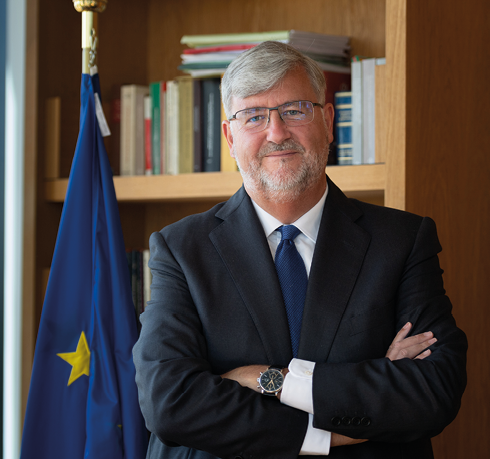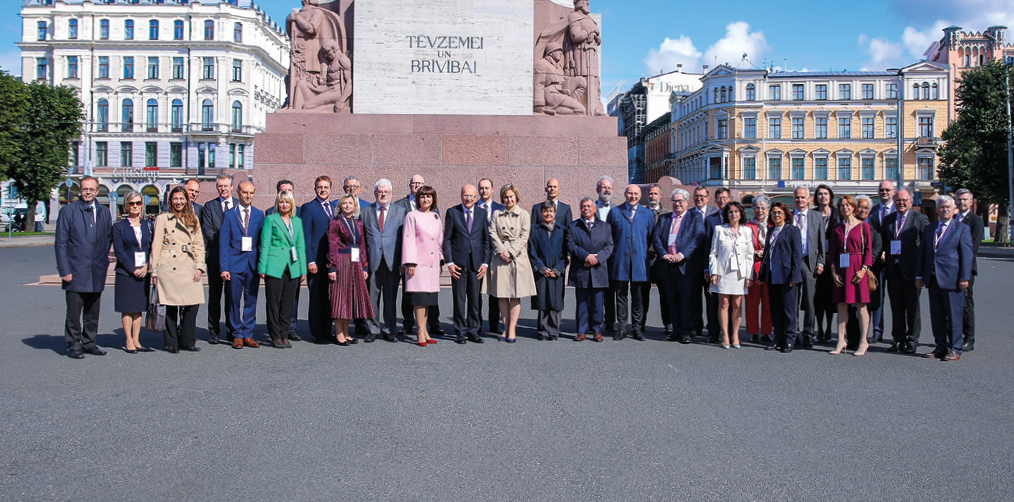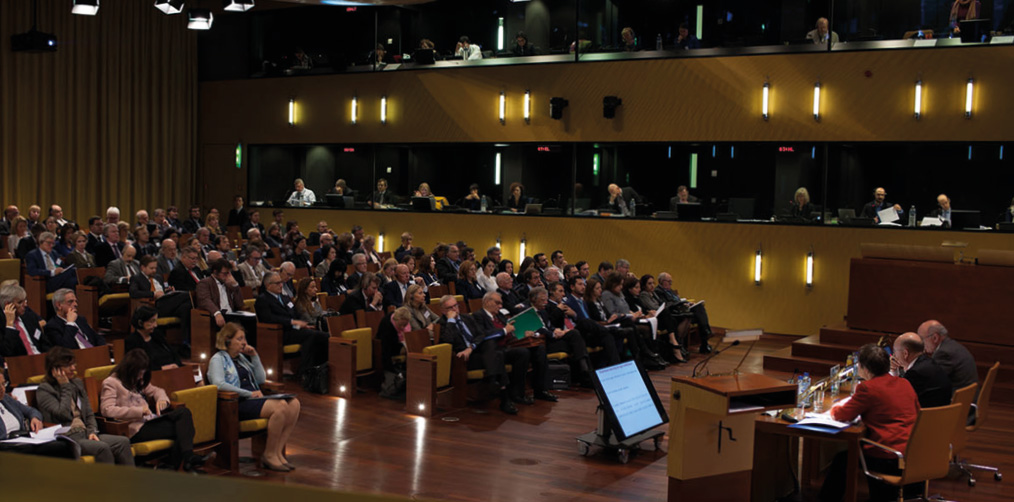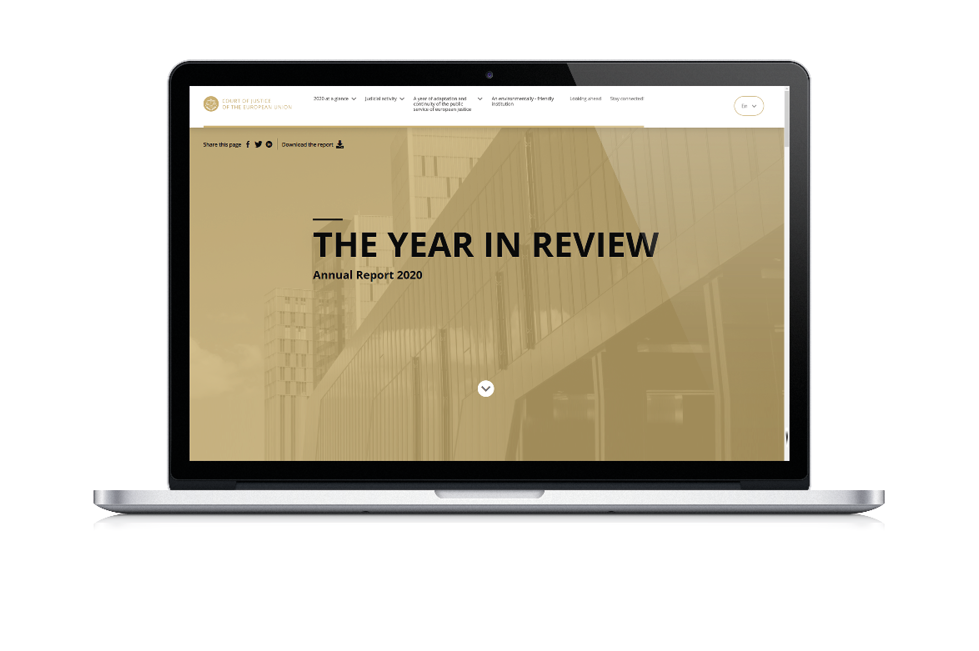A | Introduction by the Registrar
For the departments within the institution, 2021 has been a year spent consolidating the new methods implemented in 2020, with a view to ensuring the continuity and quality of the public service of European justice, in a context marked by the continued pandemic crisis and by the adaptability that this has required at both organisational and individual level.

Alfredo Calot Escobar
Registrar of the Court of Justice
The Registrar of the Court of Justice, the Secretary-General of the Institution, oversees the administrative departments under the authority of the President.
For the departments within the institution, 2021 has been a year spent consolidating the new methods implemented in 2020, with a view to ensuring the continuity and quality of the public service of European justice, in a context marked by the continued pandemic crisis and by the adaptability that this has required at both organisational and individual level. Tasks completed include the dematerialisation and simplification of decision-making processes, the increased empowerment of employees and the establishment of a new work/life balance. The remarkable results achieved by the Court of Justice and the General Court, together with the European Ombudsman’s Award for Good Administration awarded to the Court of Justice for its ‘Remote Hearings’ project in the ‘Excellence in Innovation/ Transformation’ category, are thus a source of recognition and motivation for all departments to continue along this path.
2021 was also an opportunity to broaden and accelerate the transformation of how the Court’s departments function, through the launch of several structural projects for the future.
This involves, first, increased support provided to the courts, whose workload – in particular that of the Court of Justice – is reaching unprecedented levels. Projects are therefore under way to develop information systems in the judicial field for research and drafting assistance purposes and to strengthen the direct support for judicial activities provided to the chambers of the Members of the courts. Consideration is also being given to ways, particularly technical means, of speeding up access to the contents of procedural documents.
The Court will be able to draw on the potential offered by digital tools. There is no shortage of examples: digitisation of document flows and decision-making processes, both administrative (with the finalisation of the HAN document management project) and judicial (through the integrated case management system (SIGA) project, which involves close cooperation among all departments, registries and the chambers of the Members of the courts). Both projects offer significant opportunities for streamlining processes, monitoring procedures, research and assistance in handling cases. At the same time, the IT departments monitor technology and experiment with various advanced technological tools, such as those related to the workspace or to artificial intelligence.
Second, the Court will continue to fully embrace its commitment to multilingualism, thus guaranteeing the extent of its language coverage and the quality of its services for legal translation and interpretation. This know-how is unique in the world, and should be maintained and developed by incorporating the potential of technological developments, particularly with a view to dealing with the Court’s increased workload. Behind the concept of ‘multilingualism’ lies the Court’s ability to address each litigant and each citizen in his or her own language. This is therefore a question of accessibility and legitimacy of the Union’s justice system, but also of safeguarding the cultural and linguistic diversity of the EU as a whole. This is the aim of the ‘Multilingualism approach’ that the Court has been pursuing for several years through a series of actions and events highlighting the value of multilingualism and the Court’s commitment to it. The Garden of Multilingualism, on which work began this year, will be one of the permanent and visible manifestations of this commitment, among other future projects.
Third, it is important to ensure closer contact between the Court and EU citizens, making it more accessible and increasing knowledge of its functioning among those it serves. More than ever, the Court is called upon to make decisions that have a significant political and social impact on Member States and citizens: economic and monetary policy, rule of law, asylum, terrorism prevention, fundamental rights … The far-reaching consequences of these decisions, which are often complex, require communication and explanation so that citizens are able to understand them and appreciate the fundamental role played by the EU courts. Two innovative projects intended to achieve this objective deserve to be highlighted.
One current project should soon make it possible to trial the web streaming of certain hearings before the Grand Chamber, providing yet another dimension to the principle of public hearings, in line with modern technologies. Any law student, journalist, national judge or interested citizen will be able, wherever they live, to watch the Court of Justice’s oral hearings without having to travel to Luxembourg, in all the languages covered by the interpretation services offered at the hearing. This service will open a window on Court’s daily judicial activities for the whole world.

In addition, the remote visit project – for which the pilot phase was completed in 2021 with secondary school classes in several European countries – will make it possible to diversify the options available for welcoming visitors: the majority of European citizens who are not in a position to travel to Luxembourg will be able to visit the Court under conditions that are as similar as possible to those offered to individuals visiting in person. This innovation eliminates the constraints linked to geographical distance and the perception of inaccessibility that the Court can generate among certain groups. Thanks to new technology, the Court can finally travel virtually to all citizens of the Member States.
Fourth and last, these future projects will be accompanied by an ambitious people management strategy, representing the core of the Court’s human resources policy. Organisations, whether private or public, national or European, are seeking to respond to the new context created by the development of remote working, the desire of employees for greater autonomy and the expectations of younger generations. To implement the important projects it has set for itself, the Court subscribes fully to this movement and can, as before, rely on committed and talented staff. This requires a comprehensive approach to human resources management, from recruitment methods to preparation for retirement, including skills development through initial and continuous training, job-shadowing and mentoring, as well as career management and mobility opportunities within and between institutions. To continue striving for excellence, the Court needs to create stimulating and dynamic working conditions. This includes a fundamental approach that must form the permanent backbone for the various strategies applied in the administration of the Court’s services: the mainstreaming of issues associated with diversity and inclusion throughout the life of the Institution.
I look forward to seeing you next year, when we will take stock of the year 2022, which will mark the 70th anniversary of the Court, the oldest of the EU institutions!
Alfredo Calot Escobar
Registrar of the Court of Justice



EUnited in Riga: an unprecedented judicial dialogue for a united Europe

Testimonial from Mr Inguss Kalniņš, former adviser to the President of the Constitutional Court of Latvia
For the first time in the history of the European Union, judges representing the constitutional courts and constitutional jurisdictions of the EU Member States and the members of the Court of Justice of the European Union met to discuss the common legal traditions of the European Union and how to reconcile them with the constitutional traditions and national identities of the Member States. The conference was entitled ‘EUnited in diversity: between common constitutional traditions and national identities’. It was organised jointly by the Latvijas Republikas Satversmes tiesa (Constitutional Court of Latvia) and the Court and was held from 2 to 3 September 2021 in Riga, Latvia. The idea for a joint conference that would open a dialogue between the constitutional courts and the Court of Justice was put forward in 2019 by Ms Ineta Ziemele, the then President of the Constitutional Court of Latvia, and was fully supported by the President of the Court of Justice, Mr Koen Lenaerts. It took two years to become a reality, partly because of the obstacles posed by the Covid-19 pandemic.
The specific structure of the conference, combined with the opportunity to finally meet in person, created a very enjoyable event and gave it a dynamic that made it a success in both organisational and substantive terms. All the courts present participated actively in open and frank debates, with excellent speeches and conclusions that have since been published as a volume.

To come to a common agreement on the need to engage in such a dialogue and to continue it into the future is remarkable in itself.
National and international news media and social media (#RigaJusticeConference) covered the event extensively. In addition, the Constitutional Court of Latvia launched the first episode of its on-demand audio service Tversme with Mr Koen Lenaerts, President of the Court of Justice, as guest of honour to underline the importance of dialogue.


The Meeting of Judges, a unique moment for dialogue and discussion

Testimonial from Ms María José Hernández Vitoria, President of the Employment Division of the Aragon High Court of Justice
I am delighted to have the opportunity to share my experience of the European Meeting of Judges held in Luxembourg from 20 to 22 November 2021. The meeting programme included working sessions on very different themes, so I will mention the seminars in which I participated personally.
Some of the questions raised by the judges in their speeches and discussed by the participants are of great interest to the exercise of judicial activity. Specifically, I would like to mention the discussion that developed around the right to an effective legal remedy and access to an impartial tribunal, the role played by Article 47 of the Charter of Fundamental Rights of the European Union and its scope from the point of view, in particular, of the right to effective judicial protection and to an impartial judge. The meeting provided us with a comprehensive overview of the evolution of the Court of Justice’s case-law around this precept and the legal basis it has used for its more recent case-law, from 2018 (see C‑64/16, Associação Sindical dos Juízes Portugueses). In these judgments, several provisions of the Treaty on European Union (TEU) are combined with Article 47 of the Charter: such as the provision whereby ‘Member States shall provide remedies sufficient to ensure effective legal protection in the fields covered by Union law’ (Article 19(1) TEU), the provision setting out the Union’s values, including the rule of law (Article 2), the principle of sincere cooperation among the Member States (Article 4(3)), and the provisions of the European Convention for the Protection of Human Rights and Fundamental Freedoms (Articles 6 and 13). All of us, as European judges, as judges involved in building Union law, have been able to draw useful lessons for applying the provisions of Article 47 of the Charter at national level.
Another point discussed in depth at the 2021 meeting was the notion of judicial independence, an issue that affects not only the judicial structure of each Member State of the EU, but also each member of the judiciary of these States. Accordingly, it was noted that it is not enough for a judicial body to be established by law. Guarantees must also be provided that it has no organic or functional links with the powers it is called on to supervise. As an example, we studied the question of the European arrest warrant: the Court has established that the principles of mutual recognition and mutual trust between Member States may be limited in exceptional circumstances, which means that priority must be given to examining whether a State that demands the surrender of a person from another State has a judicial system that is deficient in relation to the principle of judicial independence. This discussion, which was very valuable because it addressed these issues in practical terms, will enable national judges to deal with the doubts that arise more and more frequently in decision-making.
My colleagues and I also discussed the conditions of our profession, mentioning our duties of impartiality, but also our right to be protected from external pressure. We commented on a series of legislative measures in several Member States that affect judicial careers, such as disciplinary procedures or rules on the liability of judges, and which do not comply with the principles of EU law.
Finally, through the 2021 Meeting of Judges, we had the opportunity to attend a hearing before the Grand Chamber in a case dealing with the compliance with EU law of the rules of disciplinary procedures concerning judges adopted by a Member State. For all the participants in the 2021 meeting, this practical exercise in EU law enabled us to discover how EU justice operates, in particular because of the questions put to the parties’ representatives by the Members of the Grand Chamber. Their questions illustrated the process of legal reasoning that must be followed to solve a problem of such a complex nature.
My participation in the meeting was hugely rewarding. The knowledge I acquired there helps me clarify various legal concepts that are very useful in my daily work, where I see the increasing weight of the Court’s contributions. I left the 2021 Meeting of Judges with a tremendous sense of satisfaction, that of being a member of a European Union that provides us with legal rules enabling the peaceful coexistence of diverse people and countries, and that of having been able to rub shoulders with its judicial institution, an institution that, through the interpretation and application of the law, helps us to shape the idea of citizenship of the European Union.
Thanks to a remarkable feat of organisation, the 2021 meeting was a moment for dialogue and discussion between professionals in the field of justice, and I was able to observe, during this event, a great closeness and a sense of warmth and friendship between the participants and the Members of the Court who were significantly involved in the success of this event.


Public relations
Dialogue with legal professionals and the general public continued throughout 2021. While traditional channels were maintained, virtual dialogue was enhanced through videoconference services and social media platforms.

page-s3.sub-3.region-2.graph-1.paragraph-1
page-s3.sub-3.region-2.graph-1.paragraph-2
page-s3.sub-3.region-2.graph-1.paragraph-3
Because of the difficulties it posed for the citizens of the European Union, particularly in terms of travel, the health crisis that marked the years 2020 and 2021 led the Court to step up its efforts vis-à-vis the public. The crisis was therefore a crucial factor in the implementation of new forms of communication and an accelerator for the completion of projects put in motion before the pandemic occurred. The Court pursues a policy of openness towards citizens so that they have a better understanding of their rights through the case-law of the two courts comprising the Institution. This policy has been intensified both through the use of traditional means of communication and through the introduction of new options for access by the public.
Remote hearings, introduced in 2020 to ensure the continuity of the European public justice service, are an innovation that earned the Institution the 2021 European Ombudsman’s Award for Good Administration for Excellence in Innovation/Transformation. In 2021, videoconferencing was used for 131 hearings before the General Court and the Court of Justice. These remote hearings have paved the way for the broadcasting of oral hearings in the short term.
Press releases, intended to inform journalists and legal practitioners in real time of the decisions of the Court of Justice and the General Court as soon as they are delivered, so that they can be made known to the public, saw a significant increase in volume in 2021. 231 press releases were published in 2021, which means a total, taking into account all the language versions available on the website and sent to correspondents, of 3 206 press releases.


page-s3.sub-3.region-2.graph-2.paragraph-1
page-s3.sub-3.region-2.graph-2.paragraph-2
page-s3.sub-3.region-2.graph-2.paragraph-3
page-s3.sub-3.region-2.graph-2.paragraph-4
The Communications Directorate’s press officers have devoted their efforts and expertise to explaining judgments, orders and legal opinions, as well as ongoing cases, while at the same time increasing contacts with journalists in the Member States in order to provide them with first-hand information, raise their awareness of important cases and explain how the Courts have resolved the legal issues raised in the cases before them. Press officers distributed 601 information letters, primarily to journalists but also to legal professionals, and sent 630 ‘Info-rapids’ bulletins concerning cases that were not covered by press releases. In addition, in terms of specific requests for information concerning the functioning of the Institution or its cases, 12 538 emails and 7 182 telephone calls were received and processed in 2021 (in the language of each individual who contacted the Court) and, in accordance with the applicable regulations, the Court granted 110 requests for administrative documents and historical archives.
The Court has been present on Twitter since 2013 and continued to use this platform to inform the general public through its two accounts, one in French and the other in English, which have in total 127 700 followers. 962 tweets were sent, mainly devoted to the most important judgments delivered by the Court of Justice and the General Court and the main events in the life of the Institution. The Court is also present on the professional platform LinkedIn and sent 365 messages to its 132 000 followers.
Legal professionals, for their part, have access to ‘Fact Sheets’, and to the ‘Monthly Case-law Digest’, compilations of summaries of the decisions of the Court of Justice and the General Court which, having regard to the issues of law involved, merit particular attention. These tools, provided by the Research and Documentation Directorate, enable legal professionals to benefit at a glance from the latest case-law in general or in a particular area of European Union law.

The Court has tested and started to use the most effective IT tools so as to reach as wide an audience as possible. Whether through publication of the Annual Report l The year in review in a more convenient web format, the provision of new consultation tools by the Library Directorate, or the preparation of remote visits to the Court for groups of secondary school students, the EU’s judicial body has increased its initiatives intended for the public.

page-s3.sub-3.region-2.graph-3.paragraph-1
Organising visits is an important activity for the Court as part of its policy of openness and knowledge-sharing not only with regard to legal professionals and law students but also with European citizens. The health situation in 2021, although less strict than in 2020, has nevertheless limited visits and the volume of visitors. However, the Court has reopened its doors as far as possible and received 1 843 visitors to its buildings. The development of remote visits, using the traditional pattern for face-to-face visits, was continued and strengthened, with the organisation of 87 programmes for visits through digital platforms, thus accommodating 3 210 people.




